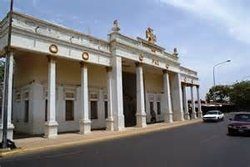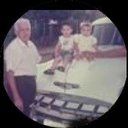
Campos Santos in our city of Maracaibo
#history
It was December 20, 1961, when cousin Sergio drowned in the waters of the lake. Cruel situation for me, a 6-year-old boy waiting for the arrival of Christmas, and packed with bagpipes and rockets.
The wake was held in my house because it was the most suitable, my old woman, she dressed me keeping me in absolute silence, she rode me in an unknown car that left us at the gates of the cemetery.
The entrance to the Campo Santo or El Cuadrado cemetery was spectacular for me, huge white walls supported a very beautiful dark wooden ceiling, giving a refreshing shade.
It was a citadel of beings from another world, beings who did not cry and were motionless, as Mom always wanted me to be.
Grabbing the old woman's black skirt, and absent from the cries and cries of the procession, I tried to understand how you could live in this magical little citadel, from which mom said, you could never leave.
Over the years, I had forgotten about the El Cuadrado cemetery, until a few weeks ago, when we had to remove cousin Sergio's bones and again I visited the cemetery.
On the way to the burial, I remembered that in Zulia there are several indigenous cemeteries, although not famous for their number.
Only with the arrival of the Spaniards did it become customary to bury the bereaved in the same churches, convents and land adjacent to them.
I suppose that the proximity to the consecrated land represented a better launch track to the other world.
This should have been taken as true by the Spanish Crown, who in 1698 ordered the dead to be buried next to the parish churches. If we locate the churches today, I imagine that more than one house, business and even first aid kit must be mounted on some old Maracaibero cemetery in the neighborhood.
This practice was changed by decree of the Liberator Simón Bolívar, in the year of 1827, forcing the dead to be buried in special lands intended for such purposes.
Following these rules, the General Cemetery of Maracaibo, or “Old Cemetery”, was created in 1829, on land located behind the San Juan de Dios church, on the famous El Tránsito street, which was closed in 1880.
The foreign colony residing in Maracaibo, founded in 1834 and closed in 1842, what became known as the cemetery of Los Alemanes, since its tenants were English, German and Jewish, it was a neighbor of the Colonial cemetery also on El Tránsito street, on the land of the current company Panorama. This cemetery was looted in 1942.
The El Cuadrado cemetery, located at the source of Las Delicias Avenue, currently next to the unfinished elevated, was born on November 12, 1879, built by a private meeting of shareholders, in what was then the furthest part of the Maracaibo of the time, the new cemetery, better known as El Cuadrado, because it has the shape of a perfect quadrilateral.
Coincidentally, the founding of El Cuadrado coincided with the attack of the yellow fever epidemic on Maracaibo, which added some residents to the new cemetery.
At that time, the surroundings of the cemetery were empty spaces of some scattered herds, resulting in El Cuadrado by 1900, the urban boundary of the city.
There are many works of sculptural and historical value, which populate this cemetery, not to mention that many of the Zulian characters of Independence and prominent Zulians from other periods rest there, such as: Jesús Enrique Losada, Ismael Urdaneta, Francisco Ochoa (buried in 2004), Jesús María Portillo, the Jugo family, José Ramón Yépez, Manuel Dagnino, Antonio José Urquinaona, Manuel Trujillo Durán, Guillermo Quintero Luzardo, Eduardo Mathyas Lossada, Julio Árraga, Udón Pérez (buried), the Belloso families, Rincón, Osorio, Cook, Arria, Von Jess, Dr. José Antonio Borjas Romero, like some of the best-known men and families.
In addition to El Cuadrado, another of the old cemeteries, now disappeared, was the cemetery of Santa Lucía, inaugurated on January 30, 1881 and closed in 1942. Later, the land became the site of several vehicle dealerships and is currently a garage.
As cemeteries, Maracaibo today has the San José cemetery, better known as El Redondo, located on Delicias Avenue with 76.
There rest remains of important figures of Zulian life: Octavio Hernández, Juan Bessón, Felipe Boscán Ortigoza, Manuel Noriega Trigo, José Antonio Butrón Olivares, Humberto Campos Brice, José Ortín Rodríguez, Adolfo D' Empaire, José Otilio Mármol, Rafael Cuencas Navas, Hugo Parra León, Raúl Cuencas, Francisco Araujo García, Fredeswinn From Cabrera, among others.
There is also the Corazón de Jesús cemetery, inaugurated in 1941, located in the middle of La Limpia Avenue next to the old Maracaibo Racecourse, and very recently the “Jardines La Chinita” cemetery.
And only for bright guests, the Regional Pantheon, of stale Colonial ancestry, the building is in the very center of the city of Maracaibo.
But while I think about so much digression, the extraction of the bones is resolved and I am walking along the lonely walks of the cemetery, looking at the dates of some tombstones and remembering. At one point I remembered the old phrase of my old woman: “You can never leave the cemetery”, I felt a slight chill and hurrying my pace, to get out, I said to myself: the problem is not being able to leave, the problem is how not to enter
https://www.pexels.com/es-es/foto/fotografia-en-primer-plano-de-lapidas-de-hormigon-116909/
- Comments (4)
- Recommended
- Milestones




Here are your recommended items...
Here are your milestones...






